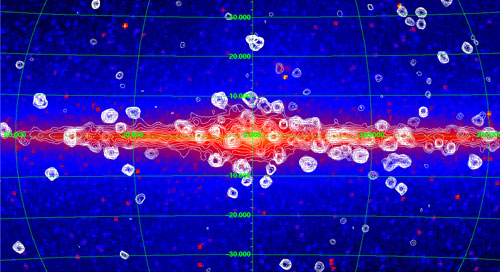Imagine the Universe News - 13 March 2006
New Map of Milky Way Reveals Millions of Unseen Objects
| 13 March 2006 |
Nearly 400 years after Galileo determined the wispy Milky Way actually comprises myriad individual stars, scientists using NASA's Rossi X-ray Timing Explorer have done the same for the "X-ray Milky Way."
The origin of this X-ray counterpart to the Milky Way, known to scientists as the galactic X-ray background, has been a long-standing mystery. Scientists have now determined the background is not diffuse, as many have thought. Rather, it emanates from untold hundreds of millions of individual sources dominated by white dwarf and stars with unusually strong coronas.
If confirmed, this new finding would have a profound impact on our understanding of the history of our galaxy, from star-formation and supernova rates to stellar evolution. While the result solves major theoretical problems, it points to a surprising undercounting of stellar objects, perhaps by a hundredfold.
Scientists from the Max Planck Institute for Astrophysics in Garching, Germany and the Space Research Institute of the Russian Academy of Sciences in Moscow discuss these results in two papers that are to be published in the scientific journal Astronomy & Astrophysics.
"From an airplane you can see a diffuse glow from a city at night," said lead author Mikhail Revnivtsev of the Max Planck Institute for Astrophysics. "To simply say cities produce light is not enough. Only when you get closer do you see individual sources that make up that glow - the house lights, street lamps and automobile headlights. In this respect, we have identified the individual sources of local X-ray light. What we found will surprise many scientists."

|
| This is an image of the galactic X-ray background superimposed on an image of infrared sources. The X-rays are shown as white contour lines. The white knots reveal very bright X-ray sources, mostly from black holes and neutron stars. Most of the X-rays in our galaxy, however, are represented by the thin, white, wavy lines. These are superimposed on a map of the infrared background (shown in orange and red) in our galaxy. These X-rays come from millions of relatively dim sources that cannot be imaged, and are from white dwarfs and stars with active coronas. (Credit: NASA/RXTE-COBE/Revnivtsev et al.) |
The X-ray background is more pervasive than the optical haze called the "Milky Way." In the early 1980's, Diana Worrall and colleagues, using data from the High Energy Astrophysics Observatory (HEAO) 1 satellite, concluded that the background was likely made up of discrete sources, such as stars with active coronae or systems with white dwarfs. But subsequent observations did not revealed enough X-ray sources to account for the "X-ray Milky Way." This has led to theoretical problems. If the X-ray glow were instead from hot and diffuse gas, it would ultimately rise and escape the confines of the galaxy. Also, all that hot gas would need to have come from millions of past star explosions called supernovae, which would imply estimates of star formation and star death were way off.
"X-ray telescopes that can resolve the emission into discrete sources looked, but they could not account for more than 30 percent of the emission," said Jean Swank, project scientist for the Rossi Explorer at NASA's Goddard Space Flight Center, Greenbelt, Md. "Many have thought that the lion's share was truly diffuse, for example, from hot gas between the stars."
The new study is based on nearly 10 years of data collected by the Rossi Explorer and constitutes the most thorough map of the galaxy in X-rays. The science team concluded the Milky Way galaxy is teeming with X-ray stars, most of them not very bright, and that scientists over the years had underestimated their numbers.
Surprisingly, the regular suspects of X-ray emission, black holes and neutron stars, are not implicated here. At higher X-ray energies, the glow arises nearly entirely from sources called cataclysmic variables. A cataclysmic variable is a binary star system containing a relatively normal star and a white dwarf, which is a stellar ember of a star like the Earth's Sun that has run out of fuel. On its own, a white dwarf is dim. In a binary, it can pull away matter from its companion star to heat itself in a process called accretion. The accreted gas is very hot, a source of considerable X-rays.
At lower X-ray energies, the glow is a mix of about one-third cataclysmic variables and two-thirds active stellar coronas. A corona is the outermost part of a star's atmosphere. Most of the stellar corona activity also takes place in binaries, where a nearby companion effectively stirs up the outer parts of the star. That energizes the stellar analog to solar flares, which emit X-rays. The science team said there are upward of a million cataclysmic variables in our galaxy and close to a billion active stars. Both of these numbers reflect a major undercounting in previous estimates.
The scientists could not image individual objects. What they saw was a perfect match between X-rays and infrared light detected by NASA's Cosmic Background Explorer mission in the 1990's. This indicates X-ray emission traces the stellar mass distribution and implies that the galactic X-ray background comprises a huge number of faint discrete sources.
NASA's Goddard Space Flight Center manages the Rossi Explorer, which was launched in December 1995.

